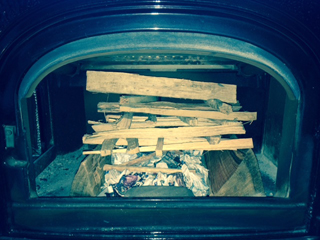
Armed with my newly acquired treasures my confidence level was running high. However, a little more research was in order; how to properly build a fire? I found a website about using wood heat. This is a noncommercial site dedicated to using wood heat in a responsible manner. This site is filled with wonderful information about burning wood for heat. I found the section on how to load the stove correctly. It appears there are several methods, some more effective than others.
By now I have concluded that my inability to have a successful fire is one or maybe a combination of the following: 1) I am doing something wrong, 2) my wood is indeed green, 3) something is wrong with my stove, 4) something is wrong with my chimney, 5) my air flow control is not effective, and 6) something I have not thought of yet. At this point I am leaning towards items number 1 and 5. After reading a little about how to start a fire I see that my previous method had two fatal errors. The first problem was based in the fact that as the newspaper burned the kindling and wood on top of it collapsed onto the paper making it hard if not impossible to do its job. The second thing I noticed is the way I loaded the stove did not allow the air flow to be utilized in the most effective manner. It was in essence creating a barrier to the flow.
One of the methods on the heat.org site suggested laying two logs parallel to each other with space for crumpled newspaper in between. On this was crisscrossed five layers of kindling with a couple of smallish logs on top of that. I placed the logs in a manner that would create a passage for the air to enter and ignite the paper and wood. This placement would allow the paper and kindling time to do their job without the collapsing that ended the previous process.
In addition, I have added a few pieces of “fat lighter’ and have made certain that my wood at this stage is seasoned. The website also suggested a crumpled piece of paper on top of the wood to produce heat for the chimney to help with the pull of the air. I did this and was pleased with my work. Striking the match and lighting the paper, starting with the one on top first, I held my breath as the process began.
It was looking like a winner. The paper flamed and started the kindling to burning. It then started to die down so I opened the door to give it more air. The flames bounced back to life and I added a little more kindling. The next few hours were spent between adding kindling and wood, trying to regulate the flow of air and being observant of how the fire was working. At times I was certain I had it while at others I was just as certain I had lost it. it seemed to be to much air with the door open and not enough with it closed. I noticed the flames seem to be consuming the wood so fast that no embers were gathering. I tried splitting some logs so they were not so large with the hope that the smaller pieces would burn easier. It was touch and go for several hours.
One thing I am certain about my process is that it should not be this difficult nor take this long. At the rate of my success, it would be a full time job to start and maintain a fire. I don’t think it should work like this. By bed time at least six hours of stove tending had passed. I had followed directions. I had improvised. But I did not resort to cursing and getting annoyed. I understand this is a process I will learn to master and I am hopeful it does not take to long.
I am coming to terms with the fact that I am in my rookie year, learning to live in the mountains.